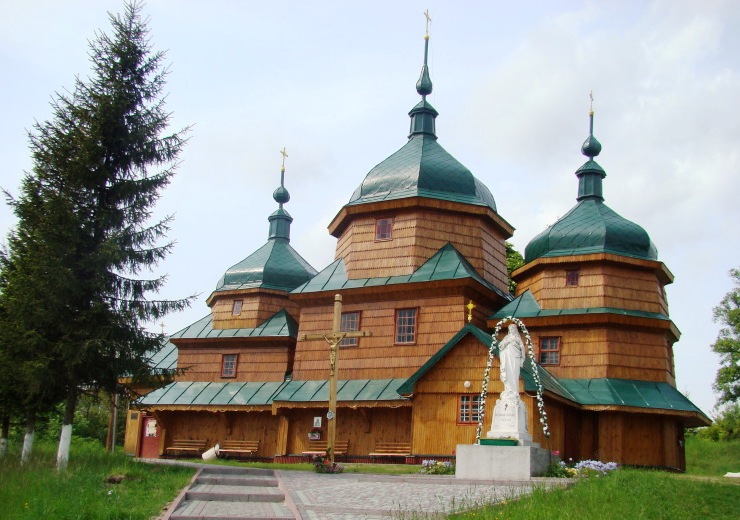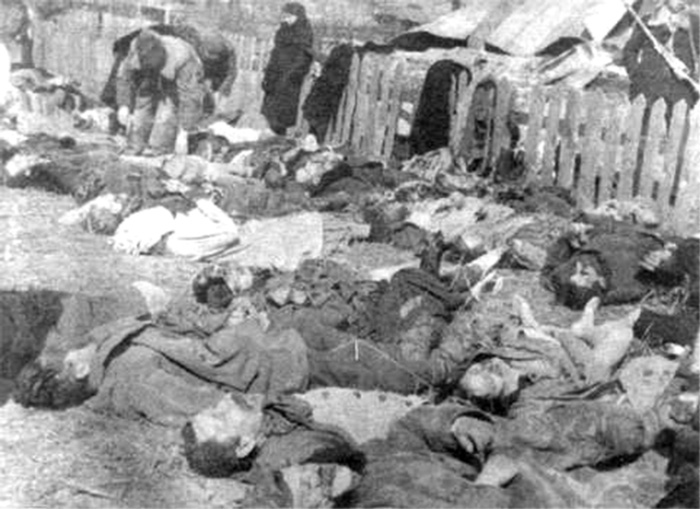|
Barszczowice
Borshchovychi (, ) is a village in Lviv Raion of Lviv Oblast in Ukraine. It belongs to Novyi Yarychiv settlement hromada, one of the hromadas of Ukraine. First mentioned in 1442 in court documents of the nearby city of Lviv. History According to a 1564 census, the village was inhabited by 20 peasants and 3 innkeepers. Decimated by three successive Tartar raids in the 17th century, by 1665 the population dropped to merely 8 inhabitants. In 1721, the village was bought by Adam Mikołaj Sieniawski who intended to rebuild the village, however a severe famine in 1726 and 1727 forces him to cede the village to the mighty Potocki family in 1729. According to the 1765 census the village was inhabited by 64 families, there are numerous weavers shops, two distilleries, a brewery and an inn. Twenty years later the population of Barszczowice includes 108 peasants and 7 artisans. Following the Partitions of Poland, the village along with the surrounding region became part of Austro-Hungari ... [...More Info...] [...Related Items...] OR: [Wikipedia] [Google] [Baidu] |
Jan Maszkowski
Jan Kanty Ignacy Maszkowski (1794–1865) was a Polish painter; known for portraits, history and genre paintings. Life and work He displayed artistic skills from an early age. A local landowner named Jozef Levitzky took note and helped him enroll in the School of Drawing at the University of Lviv, where he studied from 1813 to 1818, under the pastellist, Józef Buisset (1776-1832). He then spent three years at the Academy of Fine Arts in Vienna. His primary instructors there were Heinrich Füger and Johann Baptist von Lampi. This was followed by studies in Rome, at the Accademia di San Luca, While there, he also visited Naples, Florence and Venice. In 1824 his patron, Levitzky, demanded that he return home, which he did, after a brief stay in Vienna. Once there, he focused on painting portraits and genre scenes in Volhynia and Podolia, and had his own workshop in Dubno. From 1834 to 1843, he taught drawing at his alma mater, the university. When they closed the drawing schoo ... [...More Info...] [...Related Items...] OR: [Wikipedia] [Google] [Baidu] |
Edmund Cieczkiewicz
Edmund Cieczkiewicz (1872–1958) was a Polish painter and graphic designer. Best known for his Romantic landscapes, he is often dubbed "the last student of Matejko". Born in Barszczowice near Lwów (modern Lviv, then in Austro-Hungarian Galicia), Cieczkiewicz graduated from a gymnasium in Nowy Sącz and in 1887 joined the Kraków Academy of Fine Arts. There he studied painting under the tutelage of Florian Cynk, Władysław Łuszczkiewicz and Leon Wyczółkowski, as well as Jan Matejko and Teodor Axentowicz. He graduated in 1898, along his better-known colleagues: Józef Mehoffer, Stanisław Wyspiański, Xawery Dunikowski and Wojciech Weiss. Although a skilled painter, his personal situation prevented him from devoting his life solely to art. Instead upon graduation he started working for Imperial Royal Austrian State Railways as a railway clerk. He continued to paint though, notably portraits and mountain landscapes of the Beskids and Tatra Mountains, as well as Volhynia and ... [...More Info...] [...Related Items...] OR: [Wikipedia] [Google] [Baidu] |
Novyi Yarychiv
Novyi Yarychiv () is a rural settlement in Lviv Raion of Lviv Oblast in Ukraine. It is located approximately from the center of the city of Lviv. It hosts the administration of Novyi Yarychiv settlement hromada, one of the hromadas of Ukraine. Population: History Until 18 July 2020, Novyi Yarychiv belonged to Kamianka-Buzka Raion. The raion was abolished in July 2020 as part of the administrative reform of Ukraine, which reduced the number of raions of Lviv Oblast to seven. The area of Kamianka-Buzka Raion was split between Chervonohrad and Lviv Raions, with Novyi Yarychiv being transferred to Lviv Raion. Until 26 January 2024, Novyi Yarychiv was designated urban-type settlement. On this day, a new law entered into force which abolished this status, and Novyi Yarychiv became a rural settlement. Economy Transportation The closest railway station is located in Zapytiv, west of Novyi Yarychiv. It is on the railway which connects Lviv with Kovel via Chervonohrad and Volodymyr and ... [...More Info...] [...Related Items...] OR: [Wikipedia] [Google] [Baidu] |
Pustomyty Raion
Pustomyty Raion () was a raion (district) in Lviv Oblast in western Ukraine. Its administrative center was the city of Pustomyty. The raion was abolished on 18 July 2020 as part of the administrative reform of Ukraine, which reduced the number of raions of Lviv Oblast to seven. The area of Pustomyty Raion was merged into Lviv Raion. The last estimate of the raion population was It was established in 1959. At the time of disestablishment, the raion consisted of nine hromadas: * Davydiv rural hromada with the administration in the Village#Ukraine, selo of Davydiv; * Murovane rural hromada with the administration in the selo of Murovane, Lviv Raion, Lviv Oblast, Murovane; * Obroshyne rural hromada with the administration in the selo of Obroshyne; * Pidberiztsi rural hromada with the administration in the selo of Pidberiztsi, Lviv Oblast, Pidberiztsi; * Pustomyty urban hromada with the administration in Pustomyty; * Shchyrets settlement hromada with the administration in the urban-t ... [...More Info...] [...Related Items...] OR: [Wikipedia] [Google] [Baidu] |
Ukrainian SSR
The Ukrainian Soviet Socialist Republic, abbreviated as the Ukrainian SSR, UkrSSR, and also known as Soviet Ukraine or just Ukraine, was one of the Republics of the Soviet Union, constituent republics of the Soviet Union from 1922 until 1991. Under the Soviet One-party state, one-party model, the Ukrainian SSR was governed by the Communist Party of the Soviet Union through its Soviet democracy, republican branch, the Communist Party of Ukraine (Soviet Union), Communist Party of Ukraine. The first iterations of the Ukrainian SSR were established during the Russian Revolution, particularly after the October Revolution, Bolshevik Revolution. The outbreak of the Ukrainian–Soviet War in the former Russian Empire saw the Bolsheviks defeat the independent Ukrainian People's Republic, during the conflict against which they founded the Ukrainian People's Republic of Soviets, which was governed by the Russian Soviet Federative Socialist Republic (RSFSR), in December 1917; it was later ... [...More Info...] [...Related Items...] OR: [Wikipedia] [Google] [Baidu] |
Soviet Union
The Union of Soviet Socialist Republics. (USSR), commonly known as the Soviet Union, was a List of former transcontinental countries#Since 1700, transcontinental country that spanned much of Eurasia from 1922 until Dissolution of the Soviet Union, it dissolved in 1991. During its existence, it was the list of countries and dependencies by area, largest country by area, extending across Time in Russia, eleven time zones and sharing Geography of the Soviet Union#Borders and neighbors, borders with twelve countries, and the List of countries and dependencies by population, third-most populous country. An overall successor to the Russian Empire, it was nominally organized as a federal union of Republics of the Soviet Union, national republics, the largest and most populous of which was the Russian SFSR. In practice, Government of the Soviet Union, its government and Economy of the Soviet Union, economy were Soviet-type economic planning, highly centralized. As a one-party state go ... [...More Info...] [...Related Items...] OR: [Wikipedia] [Google] [Baidu] |
Massacres Of Poles In Volhynia And Eastern Galicia
The Massacres of Poles in Volhynia and Eastern Galicia (; ) were carried out in Occupation of Poland (1939–1945), German-occupied Poland by the Ukrainian Insurgent Army (UPA), with the support of parts of the local Ukrainians, Ukrainian population, against the Polish people, Polish minority in Volhynia, Eastern Galicia, parts of Polesia, and the Lublin Voivodeship, Lublin region from 1943 to 1945. The UPA's actions resulted in up to 100,000 Polish deaths. The peak of the massacres took place in July and August 1943. These killings were exceptionally brutal, and most of the victims were women and children. Other victims of the massacres included several hundred Armenians, Jews, Russians, Czechs, Georgians, and Ukrainians who were part of Polish families or opposed the UPA and impeded the massacres by hiding Polish escapees. The ethnic cleansing was a Ukrainian attempt to prevent the post-war Polish state from asserting its sovereignty over Ukrainian-majority areas that had be ... [...More Info...] [...Related Items...] OR: [Wikipedia] [Google] [Baidu] |
Ukrainian Insurgent Army
The Ukrainian Insurgent Army (, abbreviated UPA) was a Ukrainian nationalist partisan formation founded by the Organisation of Ukrainian Nationalists (OUN) on 14 October 1942. The UPA launched guerrilla warfare against Nazi Germany, the Soviet Union, and both the Polish Underground State and Polish Communists. The UPA carried out massacres of Poles in Volhynia and Eastern Galicia, which are recognized by Poland as a genocide. The goal of the OUN was to establish an independent Ukrainian state. This goal, according to the OUN founding declaration, "was to be achieved by a national revolution led by a dictatorship" that would drive out occupying powers and then establish a "government representing all regions and social groups"; OUN accepted violence as a political tool against enemies of their cause.Myroslav Yurkevich, Canadian Institute of Ukrainian StudiesOrganization of Ukrainian Nationalists (Orhanizatsiia ukrainskykh natsionalistiv)''This article originally appeared ... [...More Info...] [...Related Items...] OR: [Wikipedia] [Google] [Baidu] |
Operation Barbarossa
Operation Barbarossa was the invasion of the Soviet Union by Nazi Germany and several of its European Axis allies starting on Sunday, 22 June 1941, during World War II. More than 3.8 million Axis troops invaded the western Soviet Union along a front, with the main goal of capturing territory up to a line between Arkhangelsk and Astrakhan, known as the A-A line. The attack became the largest and costliest military offensive in history, with around 10 million combatants taking part in the opening phase and over 8 million casualties by the end of the operation on 5 December 1941. It marked a major escalation of World War II, opened the Eastern Front—the largest and deadliest land war in history—and brought the Soviet Union into the Allied powers. The operation, code-named after the Holy Roman Emperor Frederick Barbarossa ("red beard"), put into action Nazi Germany's ideological goals of eradicating communism and conquering the western Soviet Union to repopulate it w ... [...More Info...] [...Related Items...] OR: [Wikipedia] [Google] [Baidu] |
World War II
World War II or the Second World War (1 September 1939 – 2 September 1945) was a World war, global conflict between two coalitions: the Allies of World War II, Allies and the Axis powers. World War II by country, Nearly all of the world's countries participated, with many nations mobilising all resources in pursuit of total war. Tanks in World War II, Tanks and Air warfare of World War II, aircraft played major roles, enabling the strategic bombing of cities and delivery of the Atomic bombings of Hiroshima and Nagasaki, first and only nuclear weapons ever used in war. World War II is the List of wars by death toll, deadliest conflict in history, causing World War II casualties, the death of 70 to 85 million people, more than half of whom were civilians. Millions died in genocides, including the Holocaust, and by massacres, starvation, and disease. After the Allied victory, Allied-occupied Germany, Germany, Allied-occupied Austria, Austria, Occupation of Japan, Japan, a ... [...More Info...] [...Related Items...] OR: [Wikipedia] [Google] [Baidu] |



